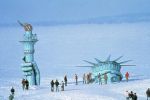Australia’s Great Barrier Reef, its wonders and its battle for survival, are a star attraction of the world’s latest internet sensation, Ocean in Google Earth.
By Science Alert Australia & New Zealand
Posted 04.02.2020 at 4:53 pm
Researchers from the ARC Centre of Excellence for Coral Reef Studies (CoECRS) are making a major contribution of science, information and underwater images to the site – launched globally today – which is designed to enable internet users worldwide to explore more fully the two thirds of the planet covered by water.
The GBR is one of a number of focal locations chosen by Google to highlight different aspects of the ocean. Others include the Galapagos, the Antarctic, the Gulf of Mexico, Hawaii, Bermuda, the West Indian Ocean and the Mediterranean.
[
Read Full Story ]









